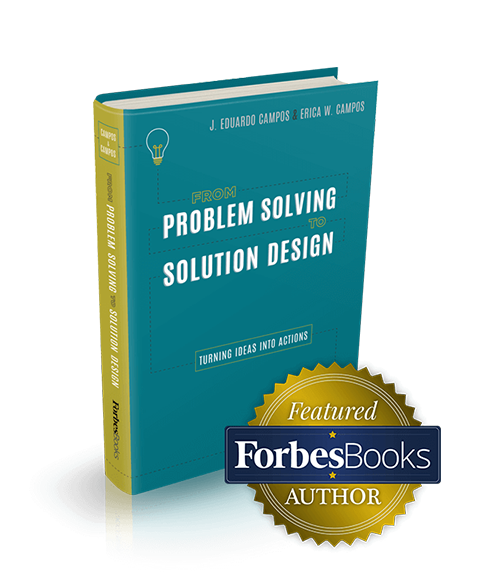The next 5 articles in this series will follow the structure established by our I.D.E.A.S. Framework, fully detailed in our book From Problem Solving to Solution Design (Campos & Campos, 2018). There are multiple potential challenges in each step of the I.D.E.A.S framework. I’ll be focusing on just one challenge per article in this series.
Let’s start with I, which stands for Identify.
With every solution design opportunity, you must step back, reflect, and clearly define the fundamental problem you are trying to solve. There are 2 key actions here: (1) define the essential problem, and (2) prioritize your actions to solve the essential problem.
Key challenges in the Identify step include:
1. Getting to the root cause of the actual problem.
TIP: Beware of solving the “symptoms” instead of the “problems”
2. Is there more than one problem?
TIP: You don’t know what you don’t know!
3. Why is it a problem?
TIP: Keep asking why until you get to the root cause.
4. Too big to work it out?
TIP: Slice, Dice and Prioritize
We’re going to focus here on Challenge #3 – Why is it a problem?
Due to the fast-paced nature of modern life, some people tend to rush to quickly solve problems, which might end up creating recurring problems, or more problems that beget other problems.
Too often, they jump in on how to solve a problem and forget to ask first what the problem is and, second, why the problem exists in the first place.
The question becomes not only “How do we define the problem?” but also, “Why is the problem happening?” Surprisingly that’s the question most people do not ask.
There’s a technique called the Five Whys, developed in the 1930s by Sakichi Toyoda (founder of Toyota Industries Co., Ltd, which would later become the Toyota Motor Corporation). The theory basically says you should not stop at the first answer that you get when you ask “why,” because there are probably more layers under that. You can identify parts of the problem or problems, then get to the root cause if you keep asking “why.” If there is another tier of “why” that you can answer, then you have not yet identified your final problem. You should keep asking “why” until you get to the root cause.
Here is a Case Study example to demonstrate the “Why” process:
The Problem: In the corporate security department of a major wholesale company focused on selling jewelry to fashion store chains, Alicia Williams was asked to make solving a “security problem” her priority.
The Issue: Vendors, clients and other visitors to the company’s biggest operations center were routinely hosted at the facility for business meetings. The waiting time at the center’s main reception desk ranged from forty to seventy minutes, just to get a badge and be escorted to the meeting destination.
From interviews with management and visitors, Alicia discovered these answers to her repeated question “Why?” Also included are the actions created to mitigate the component of the broader issue.

Because the world is not perfect, there is no endless budget for Alicia to mitigate all issues at once. Therefore, she needs to prioritize the action items, define an implementation plan, measure results, and ask for more resources. Some of these will be expanded on in future articles.
In our next article we will look at “D – Design” from our framework and review another challenge and case study.
Key Tips for the IDENTIFY Step:
- Define the problem. And remember, you might have more than one.
- Ask the Five Whys. This will help you to identify the root cause of the essential problem—what you really need to focus on and solve.
- Involve the stakeholders. Listen to all the players, ask the right questions, dance on the floor with them, and then go to the balcony to get a different perspective of the same crowd.
- Break down the problem into smaller ones and prioritize your actions to solve the essential problem.
Click here to read the Introduction to this series.
Resources:
- Click here for more on From Problem Solving to Solution Design
- Click here for a free chapter from the book.
- Are you offering solutions that matter? Click here for a free Solution Design assessment
- Click here for additional articles, interviews and podcasts


